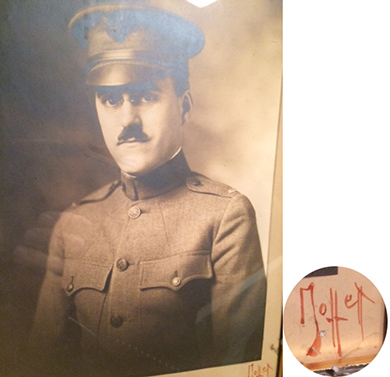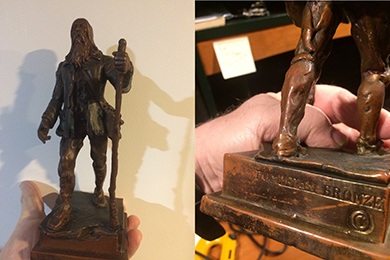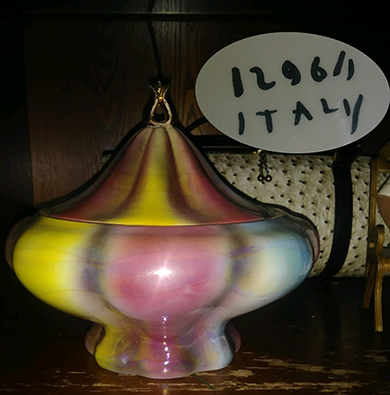 |
|
|||
 |
 |
|||
RINKER ON COLLECTIBLES — Column #1739 Copyright © Harry Rinker, LLC 2020 Questions
and Answers
QUESTION: I recently acquired a half-length portrait of an American military officer. The white mat surrounding the picture is signed “Moffett” in an elaborate script in the lower left corner. Does it have any value? – FDiB, Chicago, Email Question 
ANSWER: Moffett Studio began as a partnership between Evan Albert Evans, a Chicago real estate developer, and George Moffett, a camera artist, in 1905. Evans allowed Moffett to build a studio on the top floor of 57 Congress Street, a building owned by Evans. Evans ran the business. Moffett manned the camera. Moffett’s photographic talents included architectural, home, nature and portrait photography. Evans, a skilled promoter, provided free images of Moffett’s pictures of the rich and famous to local newspapers. The 1912 Chicago Republican Party National Convention selected Moffett Studio as its official photographer. George O. Hinchliffe assisted Moffett and excelled at elegant portraits in fashionable settings. Begining in 1908, Moffett started doing theatrical portraits. He turned his theatrical portrait business over to Paul R. Stone in the later 1910s. Underwood & Underwood acquired the Moffett Studio from Evan Evans in the mid-1920s. I sent your email containing the image of the officer to my son Harry Jr., a militaria collector and dealer, to ask if he could date the picture based on the uniform. He identified the uniform as most likely a “studio” uniform and dated the image to early World War I, possibly 1917 or 1918. The uniform shows no rank, the shoulder bar is questionable, and there are no shoulder patches. Harry, Jr., suggested de-framing the photograph to see if there is an identification number and/or date on the back. If there is an identification number, hopefully some Chicago historical museum or institution has the Moffett Studio records. If this is the case (and consider yourself extremely lucky if it is), it will be possible to identify the person. Meanwhile, you have what is known in the antiques and collectibles trade as an “instant ancestor” photograph. Any individual wishing to claim they had ancestor who fought in World War I is a potential buyer. All kidding aside (as if I was kidding), your nameless soldier photograph by Moffett has a secondary market value of around $5.00, even in the Chicago market. Collector interest for Moffett photographs focuses on his political, rich and famous, and theatrical images. QUESTION: I recently found a 9 1/2” tall figure of a man dressed in 18th century beat-up clothes. The base is incised “POMPEIAN BRASS ©.” The figurine resembles Johnny Appleseed or Rip Van Winkle. The man has no hat, long hair down to his shoulders, a big mustache, weskit type jacket, breeches, and knee socks. He also has a bag over his shoulder and holds a big walking stick in one hand. I did not have any luck finding the figure on Pompeian Brass websites. Can you identify the figure and its value? – HK, Email Question 
ANSWER: The Pompeian Bronze Works traces its history back to the Galvano Bronze Company, a New York City firm founded by Paul Mori around 1889. Galvano Bronze was one of the first American commercial companies to use bronze electroplating and electroforming. Its earliest products were architectural elements. The company introduced bookends into its product line in 1915. In the early 1920s, the Galvano Bronze Company was sold to its employees and became The Pompeian Bronze Works. Peter Manfredi, an employee, filed 27 bookend and lamp design copyrights with the U.S. Library of Congress Copyright Office in 1921. The company continued using the bronze electroplating (bronze-clad) and electroforming using white-metal (often pewter) or spelter (zinc) to make ashtrays, bookends, and lamps. In addition to a bronze finish, the company painted some of its products. Scholars are not able to agree upon the end date for the company. It appears that some of the Pompeian Bronze Company molds were acquired by Marion Bronze. For more information, see http://www.antiquebookends.us/pg/makers-bronzeclad.php. Your figurine is from a pair of bookends marketed as the “Castaways.” The pair consisted of men wearing ragged clothing – one with a walking staff and the other with a cask of rum or water on his shoulder. They are a scarce bookend combination in that the two bookends consist of different figures. They were “electro-formed” (bronze-clad). WorthPoint.com contains an eBay listing for the pair that sold on March 8, 2013 for $395.00. It was the only internet reference I could find. In pair or set value, the loss of one of the pair does not reduce the price in half but by three-quarters or more for the surviving piece. The heavy deduction is tempered in this instance by the scarcity of the figures. The retail secondary market value of your Pompeian Castaway figurine is around $150.00. QUESTION: I am seeking assistance in identifying a lamp that belonged to my grandfather who worked at Faries Manufacturing in Decatur, Illinois, before and after World War II. The lamp has a 1950s statue, very similar to those found on Reglor lamps, of an Afro-American female dancer dressed in a Caribbean / Carnival costume. There is no mark on the statue. There is a Faries stamp on the electrical lamp apparatus. It is clearly a copycat/imitation of a 1950s Reglor lamp. The lamp needs to be cleaned and rewired. What advice can you provide? – TS, Email Question 
ANSWER: Faries desk and other lighting lamps are collectible within the modernist / industrial lighting community. eBay traditionally has over 100 listings for “Faries” lamps. A WorthPoint.com listing search on April 7, 2020, produced 2,308 results. A “Faries TV lamp” and “Faries figural lamp” search proved negative. I strongly suspect that this is a homemade, one-of-a-kind lamp assembled by your grandfather for his personal use. The “romantic” alternative is that this was a prototype lamp assembled at the factory to study the possibilities of competing with Reglor. When Faries found out how aggressive Reglor was in suing any company that came remotely close to copycatting/knocking off its designs for copyright infringement, Faries decided it was more trouble than it was worth to compete. As is often the case, the tragedy is that no one in the family asked and recorded the story behind the lamp while your grandfather was alive. Brayton Laguna, Lefton and dozens of other manufacturers sold 1950s Black Caribbean / carnival dancer figurines. Your grandfather most likely acquired one of these for use in assembling the lamp. Your lamp’s value is primarily family. Outside the family, it has curiosity value to a 1950s figural lamp collector. Its secondary retail market value is between $35.00 and $45.00. QUESTION: I recently saw on a collector’s website a melon-shaped bowl with a raised melon-top and a pedestal bottom. The melon sections were decorated in alternating colors of light blue, pink, and yellow. It had a high-gloss glaze. The base is marked “129611 / ITALY.” The description said it was 70 years old. What can you tell me about the piece? – MS, Email Question 
ANSWER: The piece dates from the late 1950s or early 1960s. Although not 70 years old yet, it is rapidly approaching that age. In this instance as with so many antiques and collectibles, age is not a value factor. Although you did not include a size, the other items in the picture suggest the pedestal, covered bowl is small. There are two obvious uses. First, it was used on a woman’s vanity to hold small things such as hair clips, jewelry such as rings, pins, or small change. Second, it was a decorative accessory used on a table in the living or dining room to hold candy or some other type of sweets. The covered bowl’s secondary market value is minimal, well under $5.00. Its garage/yard sale price is between 50 cents and one dollar. It survived because it once had a family memory attached to it (now long lost) or because the owner thought it was a “pretty thing” and enjoyed looking at it. Harry L. Rinker welcomes questions from readers about
collectibles, those mass-produced items from the twentieth and twenty-first centuries.
Selected letters will be answered in this column.
Harry cannot provide personal answers.
Photos and other material submitted cannot be
returned.
Send your questions to: Rinker on Collectibles, 5955 Mill
Point Court SE, Kentwood, MI 49512.
You also can e-mail your questions to
harrylrinker@aol.com.
Only e-mails containing a full name and mailing address
will be considered.
|
||||